The way we interact with others is complex. The neural systems for self-regulation play a big role. I have learned a lot about brain control mechanisms and how they help us. They allow us to manage our urges so we can get along better with others1. My research shows that being able to control our actions to fit in with society is important. It shows we can grow personally and that our brains are designed to do this12.
Looking into how we control ourselves has shown me how adaptable we are. Our brains help us understand our behavior and guess how others might react13. This helps make sure we act in ways that match what’s expected in groups. It’s key for living together in harmony13.
Also, I found that good self-control depends on a well-organized brain2. The prefrontal cortex leads, helping us balance our wants with what’s best for the community1. This skill is crucial for leading a balanced life.
Key Takeaways
- Inhibition is a cornerstone of harmonious social integration and self-regulation1.
- Self-awareness serves as a vital psychological component of self-regulation, guiding personal conduct1.
- Changes in neural system activation patterns reflect the evolution of emotion regulation from adolescence to adulthood3.
- Top-down control exercised by the prefrontal cortex is paramount for successful self-regulation2.
- Advances in brain stimulation techniques offer potential new avenues for enhancing self-regulation2.
The Impact of Social Belonging on Self-Regulation
Feeling like we belong to a group plays a big role in how well we control ourselves. Our ancestors had to fit into groups to survive. This need has shaped how our brains work today.
We tend to follow group rules to keep our place in it. This is due to our brain’s development over time.
Understanding the Social Brain’s Role in Group Dynamics
Studies have found certain brain areas are key for being social4. These areas help us feel good and less sad when we’re with others4. This connection between being social and self-control shows how important friends and community are.
How Group Membership Influences Behavioral Expression
Being in groups like sports teams or clubs impacts our brain and behavior4. It shows how crucial being part of a community is to us. Being active in these groups makes us feel happier and more connected, a fact that was very clear during the COVID lockdowns4.
Feeling that we belong affects how we act to match group norms. When people feel left out, they tend to be less healthy and resilient4. This highlights why being in a group is good for both our mind and body.
Being included in a group helps us deal with stress. It gives our lives meaning and helps us accept ourselves. This can protect our happiness as we get older4.
| Group Type | Impact on Neural Systems | Health Outcomes |
|---|---|---|
| Sports Teams | Enhanced connectivity in default mode network | Improved physical health |
| Religious Groups | Increased activity in limbic networks | Increased psychological resilience |
| Social Clubs | Variances in ventromedial prefrontal cortex | Higher life satisfaction |
Breaking Down the Self-Regulation Process
Self-regulation is key in personal growth. It means adjusting our actions to meet our goals and dreams. It requires a mix of mind skills to make sure we act on long-term goals instead of just what we want right now. This skill is important not just in school, but in making decisions every day and in managing our emotions.
At the heart of self-regulation are a few main steps: setting personal goals, wanting to reach them, watching how we act, and controlling our urges. Albert Bandura, a famous psychologist, said self-regulation is always happening. It needs us to keep an eye on our behavior, how it changes, and its effects5.
Using self-control, like waiting for better rewards later, is critical. Studies show that being able to wait is linked to better life results. Having strong self-control predicts good personal growth, doing well in school, and getting along with others6.
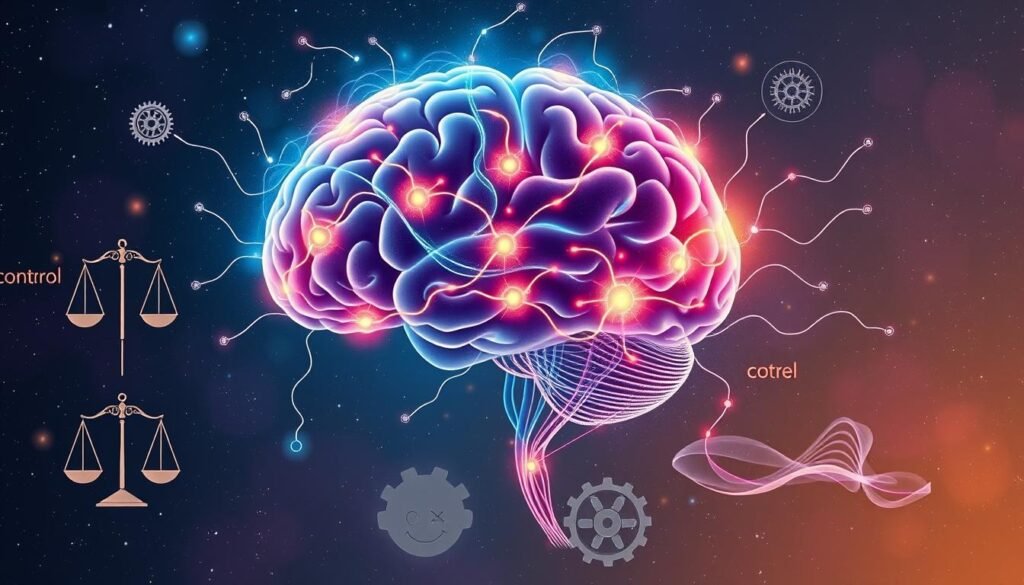
- Being able to manage our emotions is vital for our mental health and helps us deal with stress effectively5.
- The strength model of self-control suggests that using self-control a lot can make it harder to keep controlling ourselves later, leading to more impulsive actions6.
Many people find emotional self-regulation tough, which can affect their happiness. This shows how important it is to improve our self-regulation skills. Doing so can help us avoid problems like addiction and other harmful habits5.
| Factor | Impact on Self-Regulation |
|---|---|
| Cognitive Monitoring | Boosts self-awareness and helps correct off-track behaviors5 |
| Behavioral Adjustments | Helps steer our actions towards our long-term goals5 |
| Emotional Control | Keeps mood swings and impulses in check, adding to our mental strength5 |
| Self-Discipline | Is a better predictor of school success and friendships than IQ6 |
This combination of mental skills and self-control is crucial for success in work and life. By understanding and improving our self-regulation, we can better our lives and achieve our goals in many areas.
The Relationship Between Inhibition and Self-Control
In exploring the critical relationship between inhibition and self-control, we see they are key in keeping personal well-being and social harmony. Inhibition, or the choice to hold back, is crucial in matching personal wants with the wider needs of society. It helps support peace and working together.
The Need for Inhibition in Harmonious Social Relations
Inhibition is very important in how we interact with each other. It helps balance our own wants with what society expects. We see inhibition as more than a personal quality; it’s needed to solve conflicts from chasing personal gains. When we effectively use inhibition, it shows strong self-control.
This is vital for participating in healthy and beneficial social actions. By controlling urges that could hurt social peace, everyone contributes to a more united and cooperative world.
How Self-Regulation Balances Personal Pleasure with Group Norms
Self-regulation is key in mixing personal joy with social rules. This balance is essential. Without control, chasing our desires can lead to being left out or fights. Research shows that good self-regulation links to better mental health and leads to success in life7. It is important for kids, shaping their social skills and future wins7.
Inhibition’s role in self-control shows in how we manage our immediate reactions. It’s important when stopping ourselves from quick emotional responses. This control shows mature thinking and is critical for personal and social growth.
Using self-regulation well means understanding and applying control well. Knowing when to hold back can be key to personal happiness and staying away from conflicts.
In conclusion, how inhibition, self-control, and social peace tie together shows the big effect of our inner processes on social stability and personal joy. Finding the balance between our wants and the needs of others with effective self-regulation and inhibition is an important goal.
Psychological Components of Self-Regulatory Mechanisms
Self-regulation’s core lies in its psychological parts. These are key to handling social situations and reaching our goals. Learning about these parts helps us do better in life, both mentally and physically.
Studies show self-regulation involves traits like conscientiousness. This trait helps us control our actions and feelings. People who are more conscientious tend to be healthier, showing its value in self-regulation8.
Our brain’s executive functions are also vital. They handle our thoughts so we can adjust to new situations. These include working memory and the ability to switch focus. Better executive functions mean better health, highlighting their role in self-regulation89.
Having self-drive helps with adaptability, understanding, and processing info better. This drive leads to greater success in managing oneself, linking motivation directly to better results.
How self-regulation connects with our body’s reactions is crucial. For example, being able to handle stress is shown by a higher heart rate variability. This shows good mental health and self-regulation ability8. It proves our bodily responses play a big part in keeping our emotions and thoughts balanced.
When these mental processes aren’t working right, it can cause trouble. It might make dealing with stress harder and hurt our personal and social life8.
So, improving these mental aspects boosts our ability to regulate ourselves. This helps avoid problems caused by not being able to control our actions and emotions.
| Component | Function | Impact on Health |
|---|---|---|
| Conscientiousness | Predicts self-regulation quality | Linked to better psychological and physical health8 |
| Executive Functions | Manage and adapt behaviors | Improves health outcomes89 |
| Heart Rate Variability | Reflects physiological flexibility | Associated with psychological health8 |
Getting better at these areas not only helps us individually but also improves our communities and friendships. This shows the deep effect of psychological parts in controlling ourselves.
The Significance of Self-Awareness in Self-Regulation
Understanding how self-awareness aids in self-regulation is key for our growth and fitting into society. It helps us see and modify our behaviors to match social norms10. Self-awareness helps us change from the self-centered “I” to a more objective “Me” when we’re with others. This change boosts our ability to follow social rules.
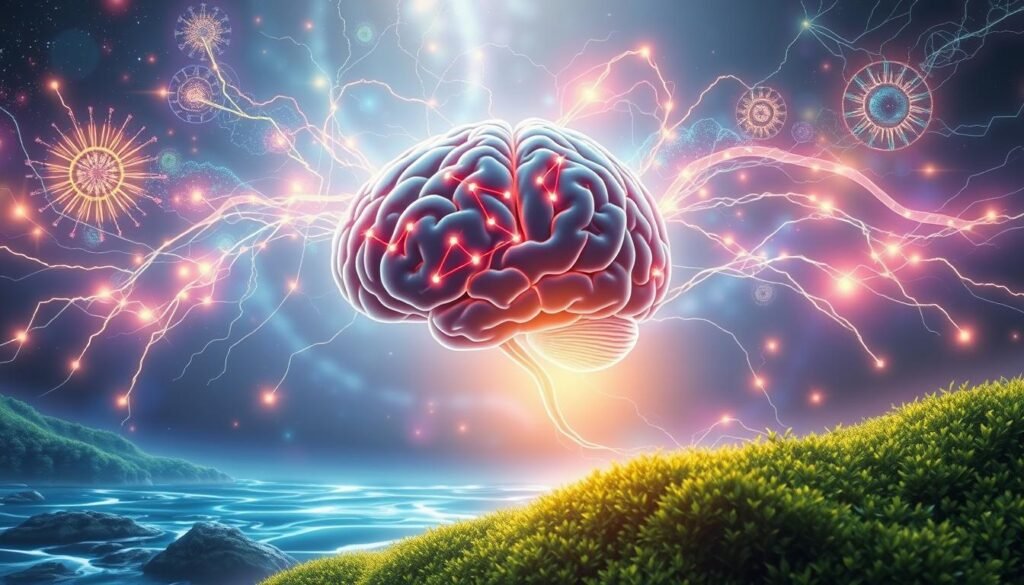
The “I” vs. “Me” Paradigm in Self-Awareness
The difference between “I” and “Me” shows deep parts of our mind. The “I” is our inner, active self, while the “Me” is how society sees us. Knowing this difference helps us stick to social rules. It creates a harmony that keeps our personal values and brings peace in the community.
How Self-Awareness Influences Behavioral Compliance with Social Norms
People with strong self-awareness are better at understanding and following social rules. This skill is about smartly moving in social settings, keeping in mind both our aims and society’s expectations. It also helps in aiming for realistic goals10, as people match their dreams with what’s actually possible.
| Self-Regulation Factor | Influence on Behavioral Compliance |
|---|---|
| Self-Awareness | Highly predictive of behavioral adjustments in social contexts11 |
| Mindfulness | Enhances memory, attention, and non-reactive state awareness |
| Goal Setting | Essential for aligning personal ambitions with external standards |
Full self-awareness guides our Goal Setting in life10. It doesn’t just boost our own happiness. It also strengthens how we act with others. Thinking about our place in society leads to thoughtful, purposeful actions.
Mentalizing: Predicting Others’ Evaluations and Reactions
Mentalizing helps us guess what others are thinking and feeling. This skill shapes how we interact and reach our goals. By understanding others’ minds, we can better connect and react in social situations. Knowing what others might think of us is key, thanks to our grasp of psychology and social cues.
This skill includes different parts, like understanding simple and complex thoughts and feelings. It gets better with more self-awareness12. This lets us smoothly handle social situations, adapting our actions to fit what we think others expect12.
The science shows that our brains are built to do this, especially areas like the superior temporal sulcus and medial prefrontal cortex13. These areas help us understand others and connect on a deeper level13.
| Component of Mentalizing | Definition | Impact on Social Evaluations |
|---|---|---|
| First-order mentalizing | Basic level understanding of others’ mind states | Essential for initial social interactions and evaluations |
| Second-order mentalizing | Understanding others’ beliefs about beliefs | Crucial in complex social scenarios like negotiations or persuasion |
| Vicarious mentalizing | Imagining oneself in another’s mental state | Enhances empathic accuracy and deeper emotional connections |
| Co-mentalizing | Shared mentalizing among groups | Important for group dynamics and collective decision-making |
Good mentalizing lets us understand others and ourselves better. Practices like setting shared dreams can improve our social skills12. This helps us achieve our goals and positively influence our community.
Getting better at mentalizing improves our social interactions. It leads to meaningful connections. Understanding others helps build a world where we all get along and grow together.
Identifying and Responding to Social Threats
In our complex social world, social threats are key in shaping our actions and interactions. The ability to spot and react to these threats is vital for social cohesion and survival. This has been important throughout human history.
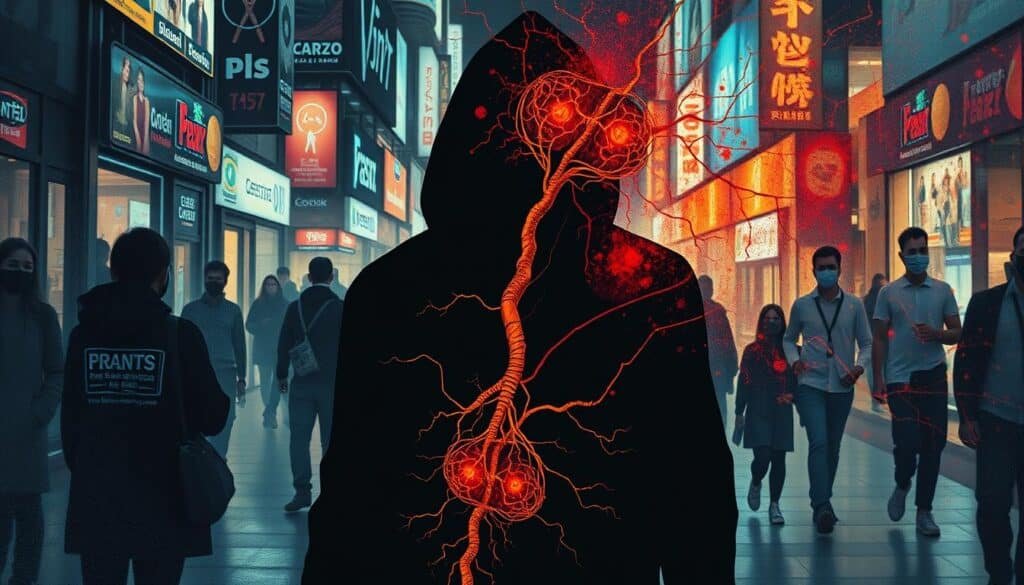
Research, including studies by Beckes and Coan (2011) and Coan, Schaefer, and Davidson (2006), shows that having social allies close affects our emotions and reactions to threats14. Being near allies helps us share the burden of facing dangers. It impacts how our brains react to perceived threats14.
The Role of Threat Detection in Social Cohesion
Seeing threats in a social setting is not just about staying alive. It’s also crucial for keeping relationships strong and the group united. Identifying threats helps everyone feel safe and belong, which creates a strong network. This network helps the group stand against threats14.
Social Sensitivity and Its Evolutionary Benefits
Social sensitivity, an evolved trait, helps us catch subtle signs in social scenes. This boosts social harmony and our collective survival. Being sensitive to these cues is key for understanding others better, strengthening social ties14. This keen awareness helped our ancestors not just live, but flourish together.
Recent studies, like those by Gonzalez et al. (2021), link social sensitivity to genetic aspects. They found DNA changes in the OXTR gene affect how we feel rewarded in social situations. This highlights how social sensitivity is deeply rooted in our biology, improving life in groups14.
As we deal with all sorts of social situations, recognizing and smartly responding to social threats is crucial. It’s essential for our mental and community health, helping both individuals and groups thrive.
Executive Functions in Action: The Mechanisms of Self-Regulation
I’ve learned that executive functions are key in controlling our reactions and choices. These skills act as the foundation of our self-regulation mechanisms. They help us evaluate and change our behavior based on environmental needs. For example, inhibitory control is vital for holding back impulses and avoiding negative consequences. This could be from overeating or falling into addictions15.
The daily habits mentioned show the importance of an achievement roadmap hinges on our cognitive operation control. The combination of working memory, attention, and mental flexibility is crucial. It keeps us on track and guards against distractions16.
The downsides of weak executive functions reach beyond personal well-being. They impact education, work, and even relationships15. Research shows those with strong executive functions achieve more in school, have better social ties, and more happiness in life17.
| Executive Function | Role in Self-Regulation | Impact on Personal and Social Outcomes |
|---|---|---|
| Impulse Control | Restrains impulsive reactions and behaviors; | Reduces risks of addiction and conduct disorders15. |
| Working Memory | Keeps information active for goal implementation; | Supports academic and professional accomplishments16. |
| Attention Regulation | Directs focus away from temptations; | Facilitates psychological stability and task completion16. |
| Self-monitoring | Assesses discrepancies between current state and goals; | Promotes adaptive behavior and better relationships1617. |
Using our executive functions well improves our mental health and builds a safe, developing society. Fine-tuning these cognitive skills shapes our personal path and our ability to create caring, peaceful, and united communities17.
Understanding and Managing Acute Stress Responses
Acute stress responses are big for our health and how we think. They impact everything from how we make decisions to our physical health.
How Stress Affects Higher Cognitive Functions
There’s a lot of research on how stress messes with our brain functions. It can really change how our brain works, especially in parts like the prefrontal cortex. This part is key for complex thinking. Stress can make it hard for this area to work right, hurting our focus, memory, and decision-making.
Some studies say a bit of stress hormone norepinephrine can actually help our brain. It works in the prefrontal cortex and helps us deal with stress. But too much or too little of this hormone is bad for our brain. It’s a delicate balance18.
The Prefrontal Cortex’s Role in Stress Response
The prefrontal cortex is super important in dealing with stress. It helps control the HPA axis, which is crucial for our stress response.
If we face a lot of stress early on, it makes our stress reaction stronger and messes with the HPA axis18. Being good at managing stress is key. It helps protect this part of the brain and keeps us resilient, both mentally and physically.
Good stress management helps keep our prefrontal cortex healthy. It makes us more resilient and helps us handle stress better. This is vital for our personal growth and for keeping us healthy in the long run.
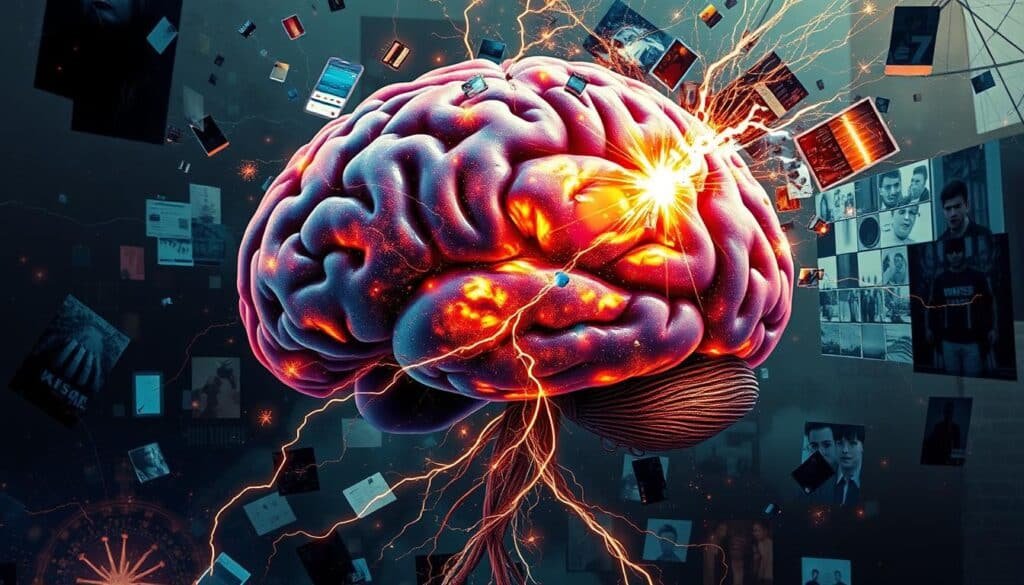
Looking into stress management is key for anyone who wants to be better at handling stress. Using tools that strengthen how the prefrontal cortex manages stress can lead to better brain function and health.
It’s important to understand these ideas if you want to use your brain to its fullest and manage stress well. Recognizing the role of the prefrontal cortex and managing stress right can really improve how we live and think under pressure.
Neural Hierarchies: Prefrontal Cortex Vs. Subcortical Dominance
The delicate balance between the prefrontal cortex and subcortical areas outlines our self-control and stress response skills. These brain control dynamics are key to mastering self-control strategies. The prefrontal cortex leads our decision-making and social behavior, controlling the instinct-driven subcortical regions.
Yet, this balance can shift, affecting our actions and feelings. In bipolar disorder, this control gets mixed up. This causes big challenges in managing emotions. Prefrontal cortex overactivity is spotted in younger people with this condition. In contrast, adults show less activity. Both experience more amygdala activity, crucial for handling emotions19. This shows the complex nature of how these brain parts interact, swinging between too much control and intense emotional reactions, highlighting subcortical dominance.
Neurotransmitters like dopamine and serotonin play roles in mood and emotion, affected by brain hierarchy. They help shape our view of social standing20. These connections shed light on how brain structures, mental health, and behavior link together. Understanding them gives us insight into the brain changes seen in mental health issues related to neural hierarchies.
Intelligence and emotional stability affect and are shaped by our social rank, involving brain areas like the prefrontal cortex. This captures the brain control dynamics essential for social and emotional balance20. Thus, social ranks are not only about our physical presence. They include complex brain processes that affect our social position and interactions.
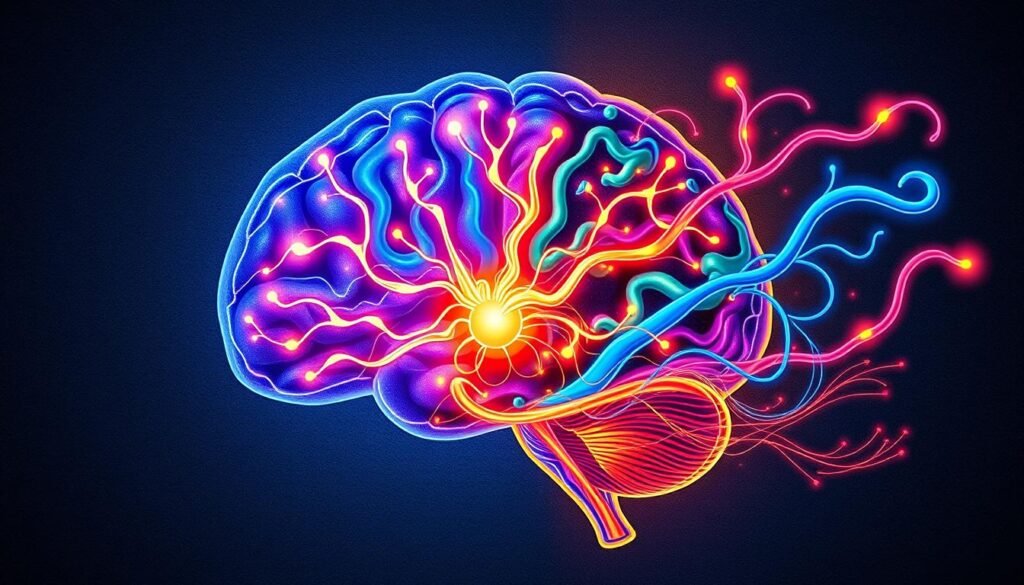
To improve self-control strategies, we should enhance the prefrontal cortex’s ability to manage stress and emotional responses. Strengthening this area helps us control impulsive reactions better. This leads to improved mental health and social behavior.
In sum, the interplay between prefrontal leadership and subcortical reactivity mirrors a wider range of behaviors and emotions. By merging scientific knowledge with psychological methods to support this neural harmony, we can better tackle life’s hurdles. This promotes a more balanced, healthier way to handle life’s challenges.
The Neurological Shift from Calm to Chaos During Stress
It’s key to understand how our brains change from calm to chaos. This happens because of both mind and brain changes.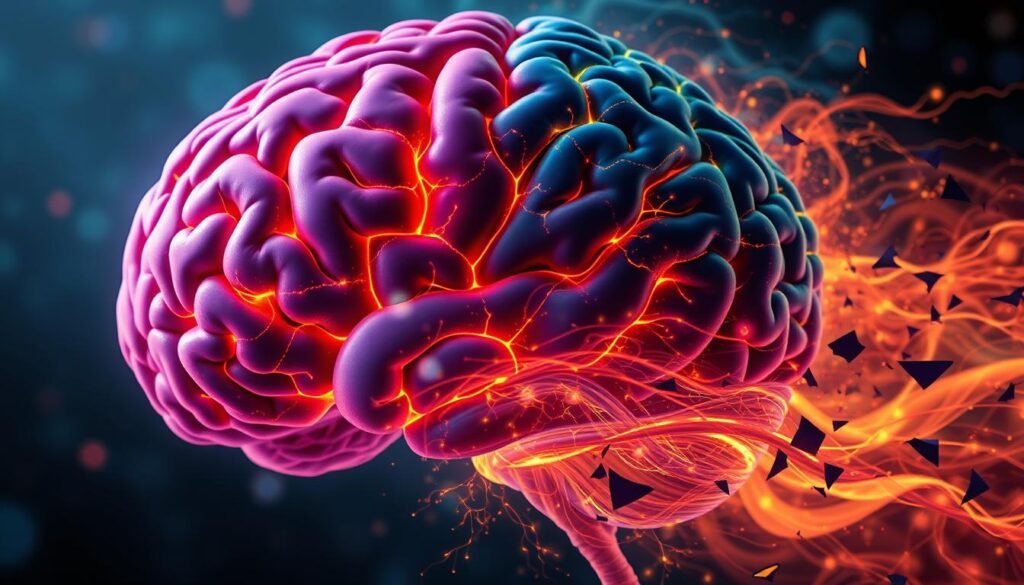
When stressed, the part of our brain that helps us make decisions gets quieter. This makes the older parts of our brain more in charge. This switch helps us see why stress makes us act without thinking21.
Stress-Induced Neural Dominance Transference
Stress-induced dominance means more than just losing impulse control. It’s about survival. Our brains shift focus from the decision-making part to the emotional part. Bi-Tapp helps bring back balance with a special rhythm21.
Behavioral Ramifications of Prefrontal Cortex Suppression
When our decision-making brain part is suppressed, we struggle more. We may find it hard to remember, concentrate, or do complex tasks. Bi-Tapp supports us continuously for 60 hours21.
| User Feedback | Benefits Noted |
|---|---|
| 13-year-old at dental appointment | Stayed calm |
| School social worker | Useful for emotion regulation in students and staff |
| Violinist with performance anxiety | Increased confidence during performances |
| Person with dementia | Managed daily anxiety, stress, and OCD symptoms |
Kids in stressful environments need strong support to bounce back. It’s crucial to make them feel safe, reassure them, and teach how to handle their feelings. The hormone oxytocin is also key in reducing stress when kids have someone they trust22.
It’s also valuable to help these kids grow after trauma. Teaching them to solve problems, plan, and manage their emotions helps them now and for life22.
Using these insights to help both adults and kids shows the big effect stress has. It’s more than just dealing with stress; it’s changing how we respond to it in good ways. This relies on old wisdom and new methods.
Strategies for Preserving Cognitive Control Under Stress
In the field of cognitive psychology, we understand how much stress impacts our mind’s control and health. It’s key to handle this stress well, not just for now but for staying mentally strong long-term. This article discusses several stress strategies and behavioral interventions crucial for keeping our minds sharp under pressure.
Studies show that being active boosts key brain functions like focusing and switching between tasks, which helps manage stress23. Making exercise a regular part of your life can guard your brain against the decline stress can cause.
To keep your mind sharp in stressful times, it’s important to do activities that keep your prefrontal cortex working. Using your working memory to stay on task is a good method. It’s part of a great life goals planner, keeping panic at bay and helping you stay calm.
Data show people with better mental control can deal with stress better. This highlights the importance of specific behavioral interventions23. Programs that include structured physical training can improve your brain’s electrical activity during tasks that need mental control, especially helpful for those often in stressful environments.
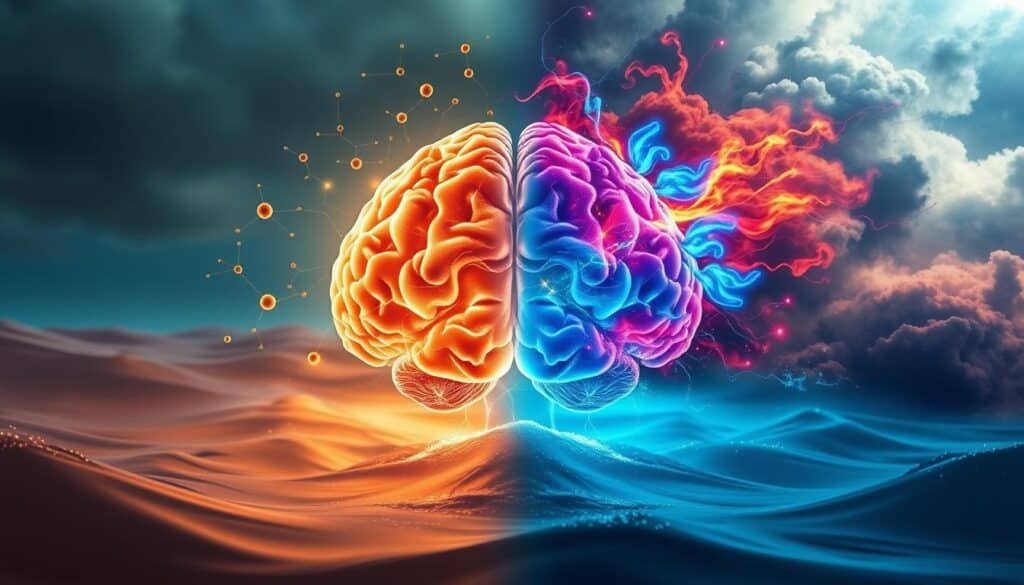
Tackling mental health problems like depression is also key as they impact mental control24. Studies indicate serious drops in brain functions, including mental control, in depressed folks. This makes stress harder to manage and staying calm a challenge. So, caring for mental health is vital for keeping our minds stable.
Kids especially benefit from learning strong mental skills early25. These skills are the base for dealing with stress throughout life and are important for children’s mental and emotional growth. Programs like Ready4Routines focus on everyday challenges and help kids and adults improve these skills, enhancing mental control during stress25.
| Intervention Type | Benefits | Targeted Cognitive Function |
|---|---|---|
| Physical Activity | Enhances neuroelectrical activity and overall physical health | Attention, Task-switching |
| Mental Health Support | Addresses cognitive deficits related to depression | Cognitive control, Executive functions |
| Structured Routines | Promotes consistency and reliability in daily operations | Working memory, Cognitive flexibility |
Using these proven strategies, we can develop a stronger mental framework to handle stress. This not only keeps our mental control in check but also boosts our success in life. It’s all about staying mentally strong and mastering stress management.
Neural Systems for Self-Regulation
The dance between thinking balance, brain systems, and self-control improvement is key in studying the brain. Recent studies on neural mechanisms highlight neurofeedback training (NFT). This lets people control their brainwaves, showing big benefits in clinics and performance26.
With tech and exercises, we can fine-tune brain stimulation. This approach strengthens brain links for better self-control and thinking balance. It’s a big advance in science and part of a larger plan to unlock our brain’s potential for better self-control26.
| Model | Accuracy | AUC |
|---|---|---|
| LASSO PCR (Holdout Data) | 78.3% | 0.916 |
| LDA (Holdout Data) | 82.5% | 0.944 |
Researchers used LASSO PCR and LDA models on 82 young adults to create neural signs for emotion control27. These models are very accurate, showing how brain systems and self-control are connected. They promise better self-control through neurofeedback and offer ways for wider studies.
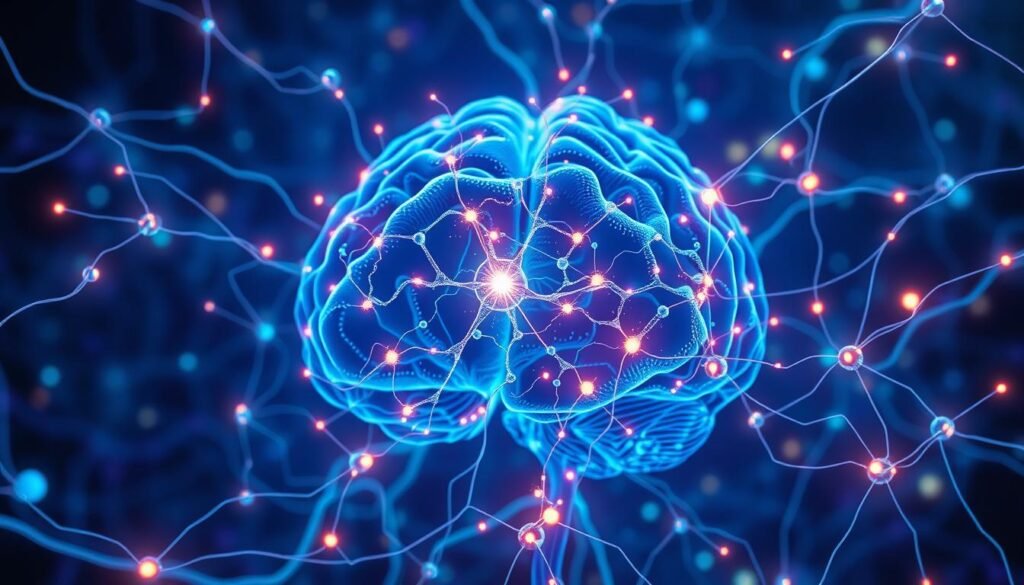
In 1929, Walter Cannon introduced homeostasis, key for self-control. It’s about keeping an ideal state for health26. Also, operational learning through operant conditioning helps us control our nervous systems, vital for regulating our body26.
Studying brain systems boosts our knowledge and pushes us to make strategies for improving self-control. These are essential for any neuroscience and psychology success plan.
The Potential for Intervention: Behavioral and Pharmaceutical Avenues
I’ve been exploring how we can better manage stress and improve our lives. I’ve found that both behavior changes and medicines have a lot of potential. These methods help us not just in tough times, but also in our daily lives by making us stronger and more in control.
Addressing Self-Regulation Failures
I’ve focused on finding ways to help people better control themselves, especially when stressed. Activities like regular exercise improve our brain function, as seen in kids who work out28. Being active leads to improved thinking and self-control28.
Not only changing habits, but also medicines are showing promise. Research on dopamine, a brain chemical, suggests new medicine could help us control urges29. Although some drugs haven’t worked as hoped, understanding dopamine’s role in addiction is key for new treatments29.
Exploring Genetic and Environmental Factors in Stress Vulnerability
Genes and our surroundings both play a big role in how we react to stress. Certain gene variations can make us more reactive to stress, impacting our self-control29. I look at how these genes, plus factors like where we live and our income, affect our stress levels30.
With this knowledge, I recommend personalized plans to deal with stress. This is especially important in places with a lot of stress, to prevent problems before they start.
Knowing how to adjust these plans for each person can really improve our mental health. This way, we can handle the challenges of stress and self-control better at all stages of life.

All these insights make me want to include different strategies in handling stress. By combining behavior changes, medicines, and understanding our genes and surroundings, we can better face stress. This not only helps in stress management but also improves our overall happiness and resilience.
Gender Differences in Stress Responses and Self-Regulation
Studies show that men and women handle stress differently because of biological reasons, like hormone differences. For example, estrogen has a big impact. These differences affect not just our minds but society too. It’s important to understand this to help people better.
How Estrogen Influences the Stress Regulation in Women
Estrogen plays a big role in how women deal with stress. It affects things like cortisol levels. This means we need to find ways to help women manage stress better. This is especially true because it can really impact a woman’s mental health.
The Varied Social and Biological Impacts of Stress Across Genders
Men and women feel and deal with stress in different ways. This can change how healthy they are and how they get along with others. They even have different physical reactions to stress, like changes in heart rate31.
There’s research that shows men and women use different parts of their brains during stress32. This means we need different ways to help men and women with stress.
Learning more about how estrogen affects stress can help us come up with better ways to help. This is really important for helping women who are going through tough times.
Studies using brain scans show that men and women handle stress with different parts of their brains32. This shows just how connected stress and biology are.
| Factor | Impact on Men | Impact on Women |
|---|---|---|
| Cortisol Response | Higher activation in prefrontal regions | Greater limbic/striatal responses |
| HRV During Stress | Lower compared to women | Higher, indicating better emotional regulation |
| Prevalence of Depression | Lower incidence rates | Higher, linked to stress sensitivity |
To wrap it up, understanding how estrogen and self-regulation work against stress is vital. By focusing on what each gender specifically needs, we can make a big difference in their health. This means creating special plans that respect these differences.
Conclusion
The journey to master self-control and use our brain’s power better is important for both personal growth and living together peacefully. We learn about how our brain works, like how it deals with tough situations, by looking at brain scans from fMRI studies. These studies show us how trying to manage our feelings lights up certain brain areas tied to thinking and control, teaching us about the bond between our brain’s control systems and mastering self-control33.
It’s also fascinating to see how the amygdala and parts of the frontal lobe of the brain interact in a detailed way33. When we’re trying to stop certain actions, the right side of the frontal lobe gets busy. But when we bring up emotions, the left part plays a key role33. This complex brain dance shows the science behind our ability to grow personally and handle stress well.
Looking ahead, research should think about the effects of different life experiences, like those seen in studies on children who have been treated badly, on how well we can control ourselves and our mental health34. Applying these findings in real-life settings, like schools or personal growth programs, is a big goal. It would help us build a life that makes the most of our brain’s power to regulate feelings and thoughts, even during hard times.
FAQ
What are the key components of the brain’s control mechanisms for self-regulation?
Four main parts make up the brain’s control for self-regulation. These are self-awareness, social understanding, spotting threats, and executive skills. These skills help solve conflicts between what we know and social rules.
How does social belonging affect self-regulation?
Feeling like you belong in a group shapes how we act to keep our spot. Our brain’s self-regulation systems are tuned to social situations. Being part of a group and following its rules was key for our ancestors’ survival and still matters today.
Can you explain the process of self-regulation?
Self-regulation involves starting, changing, or stopping our thoughts, feelings, or actions. This helps us reach personal goals or meet standards. It needs self-control strategies and is a key personal growth tool for changing behaviors.
Why is inhibition important for self-control?
Inhibition keeps our personal desires and group expectations in balance. It’s vital for getting along with others. It holds back impulses to prevent social issues and keeps group peace.
What are the psychological components involved in self-regulatory mechanisms?
Key parts of self-regulation include self-awareness, understanding social cues, spotting threats, and adjusting behavior. These skills help us change and adapt our actions. They are essential for thinking flexibly and succeeding.
How does self-awareness impact behavioral compliance with social norms?
Being self-aware lets us judge our actions against group norms. This helps our behavior match what’s expected, supporting our goals.
What role does mentalizing play in self-regulation?
Understanding others’ thoughts helps in self-regulation by predicting how our actions look to them. This skill helps us change our actions to fit in and keep social peace.
Why is threat detection important for social cohesion?
Spotting social threats helps keep everyone getting along. It’s key for understanding social cues, which is crucial for groups to work well together and survive.
How do executive functions contribute to the mechanisms of self-regulation?
Executive functions help us adjust our thoughts, actions, and feelings to fit social situations. They are key for managing self-regulation, leading to success in personal and social areas.
How does acute stress affect cognitive functions related to self-regulation?
Stress messes with important brain functions, hitting areas that control focus, choices, and memory. It causes changes that weaken brain control, harming our ability to regulate ourselves. Managing stress is crucial for personal growth.
What happens in our brain during a stress-induced shift from calm to chaos?
When stressed, our brain’s control moves from more advanced areas to older ones. This results in less memory, broken control networks, and spontaneous actions, hurting our self-regulation.
What interventions exist to help manage self-regulation under stress?
Both behavior and medicine can help keep control under stress. Strategies include managing stress chemicals and keeping a stable mind, essential for staying calm when stressed.
Are there gender differences in how stress impacts self-regulation?
Yes, stress affects self-regulation differently in men and women. For instance, estrogen might make women more stress-sensitive. This means men and women might need different ways to handle stress and self-regulation.
